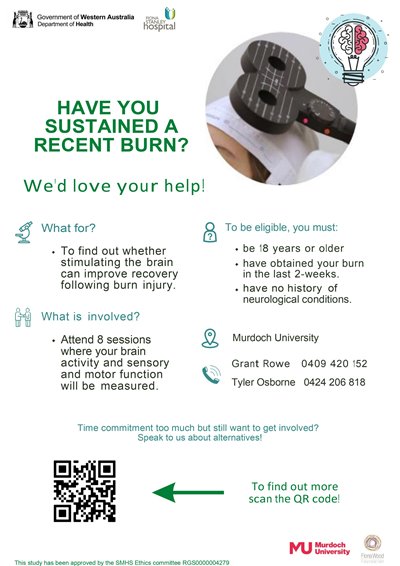Neuroplasticity Brain Study
Understanding Neuroplasticity in Burn Injury Recovery
Burn injury is likely to drive changes in the brain, known as neuroplasticity, but we do not know if neuroplasticity following burn injury is functionally beneficial or maladaptive. If we can harness beneficial neuroplasticity, we can develop interventions to target the brain and enhance patient outcomes following burn injury.
A Message from Professor Fiona Wood
Learn about the groundbreaking research on neuroplasticity following burn injuries from Professor Fiona Wood. Watch the informative video below to understand how this study could redefine burn injury treatment and recovery.
Frequently asked questions
For comprehensive details about the study and participant involvement, please review our factsheet. It answers the most frequently asked questions and offers in-depth insights. You can access the PDF by clicking here.
Study Information
1. Intervention Study
Objective: Examine if non-invasive brain stimulation can improve functional outcomes.
Requirements: Participation in five 45-minute sessions for brain targeting and three 2-hour sessions for measuring brain activity, movement control, and sensation.
2. Tracking Study
Objective: Track brain activity and recovery progression.
Requirements: Three 2-hour sessions, spaced 4-6 weeks apart, measuring brain activity, movement control, and sensation. Sessions align with clinical follow-ups.
3. Persistent Changes Study
Objective: Assess long-term effects of burn injuries.
Requirements: One initial 2-hour session and a potential follow-up a year later to measure brain activity, movement control, and sensation. Focus on patients 1-5 years post initial burn.
Watch the information video
For a more detailed overview of these studies, please watch this video by our research team.
Interested in Participating?
Contact the research team for more information or to express your interest:
This study has been approved by the SMHS Ethics committee RGS0000004279
